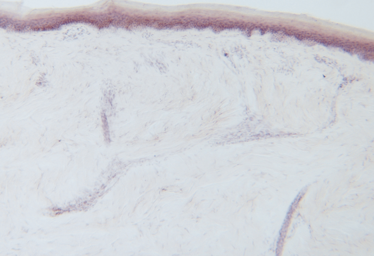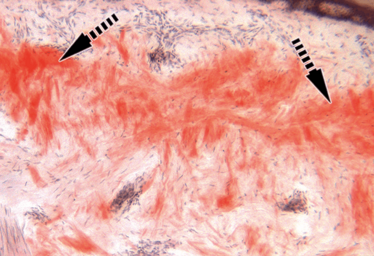Better Biopsies for Amyloidosis?
A more rapid alternative for familial amyloid polyneuropathy diagnosis
Transthyretin-mediated amyloidosis (TTR) is an inherited condition that causes familial amyloid polyneuropathy (FAP), a disease that often proves fatal within just a decade. TTR-FAP is usually diagnosed by sural nerve biopsy and genetic testing – but it is a highly invasive procedure, and distribution of the amyloid aggregates needed to make a diagnosis can be patchy. And that’s why correct early diagnosis of the condition is uncommon (1).

Figure 1. A healthy skin biopsy. Image credit: Michael Polydefkis

Figure 2. A healthy skin biopsy; b. a skin biopsy from a patient with amyloidosis, with amyloid clumps in red. Image credit: Michael Polydefkis
A group of Johns Hopkins physicians have developed a modified approach using a skin punch biopsy, with the aim of creating a faster and relatively less invasive method of diagnosis. In a study of 30 FAP mutation carriers, 40 controls, and two patients with non-inherited amyloidosis, distal leg skin punch tissue samples stained with Congo red had 70 percent sensitivity and 100 percent specificity in diagnosing TTR-FAP (see Figure 1). The team also found that higher levels of amyloid aggregate were associated with loss of nerve fibers – which could lead to a new method of estimating disease severity and monitoring progression. They hope that, with a potential method for providing diagnostic and prognostic information less invasively, clinical trials of therapies could advance more quickly.
The current method has only been tested on the most common FAP-causing TTR mutations, but the team hope that their work can be built upon. “If further studies confirm and extend what we have found, we may use the skin biopsy as a biomarker for disease severity. And we will be able to diagnose more patients sooner,” said Michael Polydefkis, professor of neurology and senior author of the study. “The good news is that drug companies are using our skin biopsy technique in ongoing clinical trials to monitor treatment success. (2)”
- GJ Ebenezer et al., “Cutaneous nerve biomarkers in transthyretin familial amyloid polyneuropathy”, Ann Neurol, 82, 44–56 (2017). PMID: 28598015.
- Johns Hopkins Medicine, “Faster diagnosis of inherited and lethal nerve disease could advance search for new treatments”, (2017). Available at: bit.ly/2xgebL1. Accessed October 4, 2017.
I have an extensive academic background in the life sciences, having studied forensic biology and human medical genetics in my time at Strathclyde and Glasgow Universities. My research, data presentation and bioinformatics skills plus my ‘wet lab’ experience have been a superb grounding for my role as an Associate Editor at Texere Publishing. The job allows me to utilize my hard-learned academic skills and experience in my current position within an exciting and contemporary publishing company.




















